Tide and Time: The Danny Hampson Story
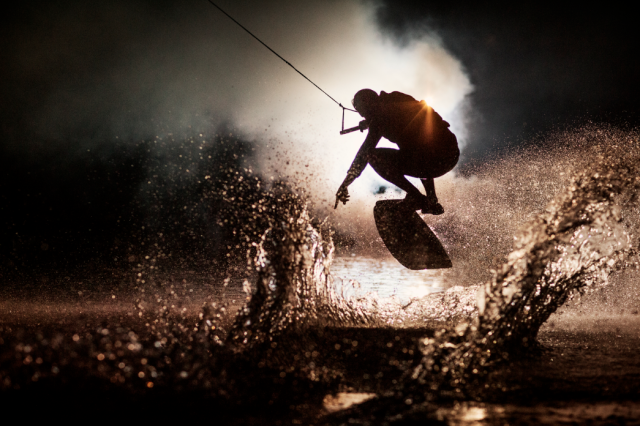
Hand on the handle, Heart in the sky. Photo: Soderlind
Fifteen years ago wakeskating was pretty much a novelty – a playful little diversion for most riders to break up long days spent wakeboarding. There were, of course, guys that took it a little more seriously. Scott Byerly is credited with debuting the sport to the public in the early 90’s, rubbing surf wax on his wakeboard and doing a 3-shuv for an instructional in WakeBoarding magazine. Several years later, a West Coast skater named Jason Messer developed something called Fresh Water Traction pads – foam rubber foot decks designed to screw into the binding holes of a wakeboard to make the activity less like surfing and more like skating. Still, not many people back then seemed to think much would become of it.
Around the millennium, one guy blatantly disagreed: Thomas Horrell. Thomas had been one of the premiere names in wakeboarding during its early days, and had, if not necessarily the respect, certainly the attention of everybody in wakeboarding. Whatever Thomas did, people took notice. So when he suddenly showed up one day in the late 90’s with skate shoes and a wooden board covered in grip tape, people laughed. But they didn’t look away.

The Keys and Danny. Photo: Letchworth
Over the next couple years Thomas was wakeskating, doing more to promote and develop the attitude, moves and movement of it than everyone else combined. He was the first to film video full video parts on a wakeskate, the first to perfect an arsenal of lip tricks and the first to actively encourage and inspire others to follow in his path. Soon, guys like Brian Grubb, Collin Wright, Scott Jobe, Jim Leatherman, Aaron Reed and Drew McGuckin started to devote themselves entirely to the fledgling sport.
But despite all Horrell had done, wakeskating still craved for expansion and attention. Most people who knew it well back then had a growing sense – or hope – that something big was on the horizon, but no one knew what, or who, that was.
Sometime around the Fall of 2002, Thomas started talking about a kid he had watched ride in Miami. A kid that Thomas claimed had absolutely blown his mind with a combination of style and raw talent he had never seen before. It was no small declaration. Now, Thomas was also one of the most animated and opinionated people I knew, and it was common for him to boldly declare even the most mundane of things the best, or worst, ever. As in, “Like seriously Tone, those shoes you’re wearing are the worst thing ever.” Or, “Seriously, that shirt you’re wearing is the worst thing ever.” So when he said something along the lines of, “Seriously, this kid is the future of wakeskating,” I probably didn’t follow it with all the attention I should have.
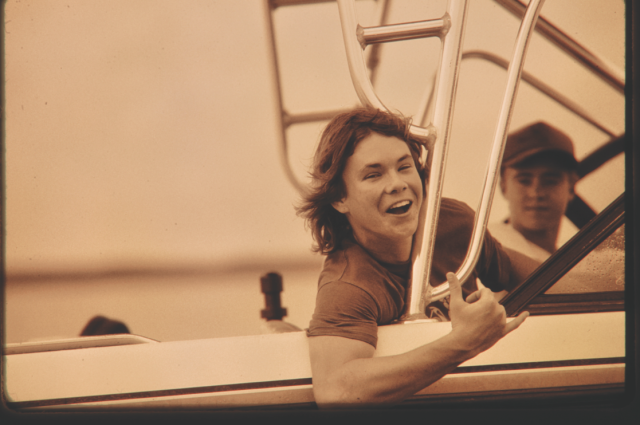
Dock Life. Photo: Letchworth
A few days later I overheard former professional riders Chase Heavener and Jim Leatherman talking excitedly about the same Miami trip, and the same kid. Keep in mind that this was a trip that included all the heavy hitters on the Cassette Wakeskates team at the time, which basically meant that it contained about 85% of the heavy hitters in the sport. And they were all saying the same thing, “It’s crazy, he’s only 14 years old.” Back then, the measure of a wakeskater was in large part about his ability to do a kickflip, and the gossip was that this kid already had kickflips locked down as good or better than even Horrell.
Soon after, on the light table at the Alliance offices in California, I opened a packet of (film) images from photographer Josh Letchworth marked “Miami – Cassette” and came across the shot that would forever be my first impression of Danny Hampson. There beside a boat full of the best wakeskaters in the sport, floating in the shallow, royal blue water of Biscayne Bay was a tiny waif of a kid I had never seen. He couldn’t have been a feather more than 100 pounds, with intense, green cat-eyes that stared straight through the lens. The look was what got me. It was confident for a 14-year-old, comfortable in his element. It had the air of both pirate and punk; kind of an old soul with new blood. And I knew this was the kid they had been talking about. In a couple of months, everyone else would know him too.
Before there was Danny Hampson the pro, the pioneer, the wakeskating legend who burst onto the scene and took the entire sport by storm, there was just that little determined kid. A kid whose sole dream growing up was not to be a professional wakeskater, but a professional wakeboarder.
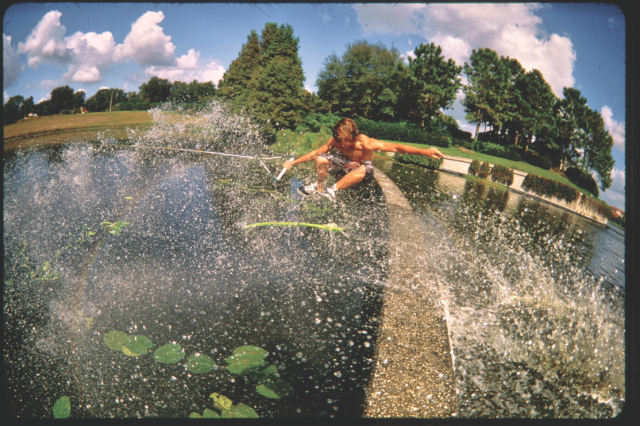
Flashback to the Metrowest Gap – Circa 2004. Photo: Letchworth
Surprised? Me too. But it was part of the many things I found out about a guy who I’ve come to know much better in the past few months, while we’ve been working on his documentary Tide and Time: The Danny Hampson Story, which is being produced by Oakley and Alliance Visual Experiences. His path from fan-boy to phenom started almost from birth.
“My very first memory was in the water,” Danny says. “I was probably about three years old and I had to pass my swimming test, so my dad took me to the local pool to practice. He put me in the water with all my clothes on and had me swim to the wall. I just remember being underwater, pretty much drowning, but being really calm and peaceful, and just reaching out for that wall. In a lot of ways I’ve been reaching for that wall ever since,” he says with his trademark chuckle.
Danny’s close interaction with water at an early age was as much by fate as design. He was born and grew up in Tavernier, Florida, on Plantation Key, one of several islands that make up the archipelago of the Florida Keys. Water was never more than a few hundred yards in any direction, and boats were as abundant as bicycles for the kids that grew up there.
His dad, Tim, an all-around waterman, fishing guide and captain, got Danny started early on kneeboarding, spearfishing, diving and more. Occasionally he would let his passion for skateboarding spill over into the water, and do a few tricks on a homemade wakeskate. But wakeboarding was still the hot ticket, and Danny couldn’t get enough. As he and his friends got older and better at it, they longed for some instruction to take them to the next level, so in early 2002 the group from Plantation Key (the Indian Mound Boys, named for the street they grew up on) took a trip to the Wakeboard Camp in Orlando. It turned out to be a journey that would shape the course of not only Danny’s his life, but the course of wakeskating.
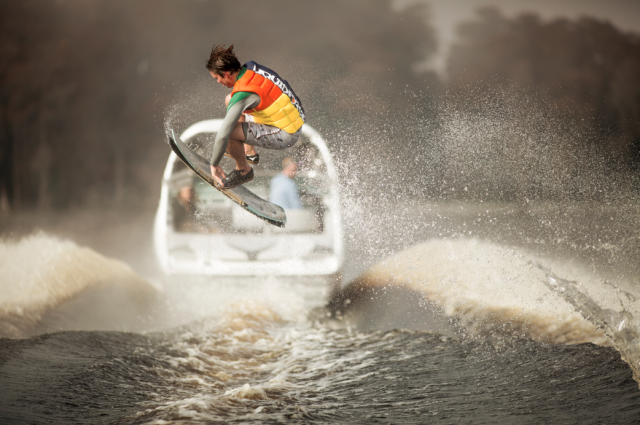
The frontside bigger spin Danny made famous. Photo: Soderlind
“Wakeskating wasn’t really too big at the time, but we all knew who Aaron Reed was from the magazines, and knew he was an instructor at the camp,” says Hampson. “So my friends said ‘You should wakeskate for him.’”
Reed remembers that first ride vividly, “He was just this little kid that had been at the camp all week wakeboarding, and his friends were all telling me they wanted me to see him wakeskate. So he gets out there and immediately I was just blown away. I don’t even think he realized how good he was. He was just going for it, not holding back at all, doing all these tricks that were basically as good as any I had ever seen. He was just crushing it. I basically told him right then and there to stop wakeboarding, and only concentrate on wakeskating. And I also told him to go home and film a sponsor me tape and I would give it to Thomas Horrell.”
A few months and countless hours of filming later, Horrell walked out to his mailbox and pulled out a neatly wrapped brown envelope addressed in neat, if juvenile, handwriting by “Daniel Raymond Hampson.” He popped the tape in the VCR, and within a matter of minutes, the leader of the best team in wakeskating knew he had found the prodigy he had been looking for.
“Yeah, it was obvious we were witnessing the future of wakeskating,” says Horrell. “No question. And from a 14-year-old kid.”
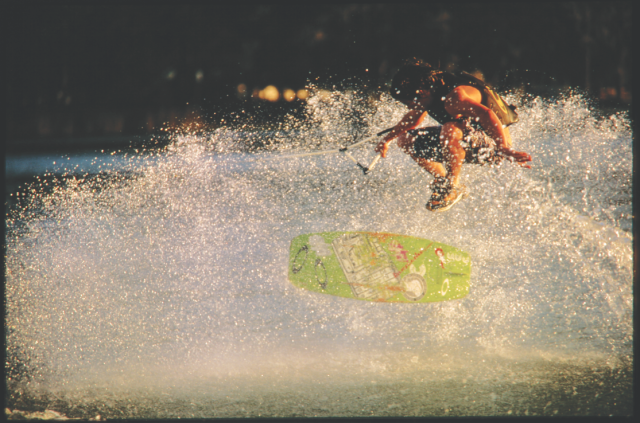
Kickflippin Early. Photo: Letchworth
The months that followed were a whirlwind for Hampson. He signed on with Cassette, put his wakeboard on the shelf in the garage and traveled to Miami to start filming for the upcoming team video, Sfumato. It’s arguable that Sfumato changed wakeskating from the activity that had always been secondary to wakeboarding, to a stand-alone pursuit. The opening section was a big part of that shift, focusing on the skate-style talents of the previously unseen teenager. Keep in mind, in 2002/2003, there was no instant viewership. No cell phone videos or GoPro shots. The magazines would occasionally run a wakesakting sequence, but if you really wanted to see the future you had to wait for the video. Sfumato was like the public’s first glimpse of a royal heir.
“He was the same as Danny Harf – the new guard,” says Jobe. “He did everything better than everyone before him. He did it more consistently. He did it with more power. He did it with more style. He did it with more pop.”
A career was born.
In the mid 2000’s, Hampson created the canon of work he ultimately would become most known for. His style and ability were maturing as he grew, and video producers from almost every wakeskating movie made during the time were clamoring to get him involved. Danny was selective, choosing to film with people he had personal connections with and building a reputation for not only being the best athlete, but the most creative thinker. He had a particularly close bond with Heavener, for which he collaborated on both Pre-Pop and Oakley’s Push Process, two movies that were benchmarks for progression and perception of the sport. He was part of the first all-wakskate movie made by Justin Stephens, Asterisk. All the while, his riding continued to push the boundaries of what had been seen before.
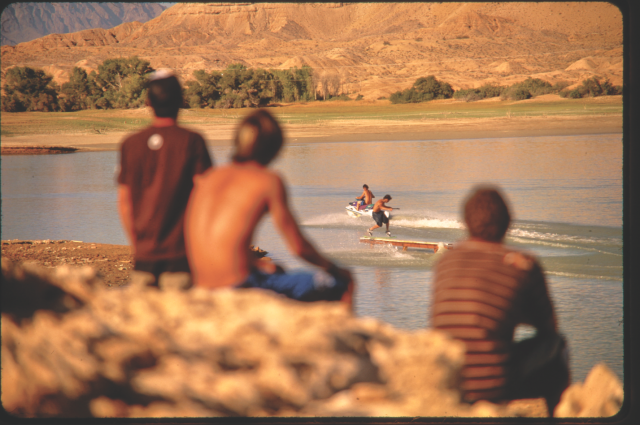
*Asterisk. Photo: Letchworth
“Danny’s progression in the flip tricks seemed like they were happening on a weekly basis,” says Leatherman. “Varial flips, frontside flips, wake-to-wake flip tricks and a number of other technical aspects of his riding that a lot of people could only dream about. He changed the game.”
Along with the notoriety and acclaim came the opportunity for a teenage kid to travel the world with guys five to 10 years older than him. Not just guys – the hardest partiers in wake sports. He grew up quickly – mostly for better, sometimes for worse.
On Mother’s Day 2006, during some downtime in Tavernier, Hampson had spent the day with friends at a party on a sandbar just a few miles from his house. As the group sped back home for Mother’s Day dinner, Danny was perched on the bow of the boat when the driver started flying between the narrow mangrove stands at about 50 miles per hour.
“We were going too fast and he just lost control of the boat for a split second, but that was all it took,” Danny says. The boat ran head on into the bushes, stopping immediately and launching Hampson backwards about 20 yards into a tangled, branchy mess. “I was actually hanging in the trees with my arms out, and a branch had punctured my neck.”
Not only was Danny’s neck punctured, but it had also broken from the force of being thrown from the boat.. Danny suffered what’s known as a hangman’s fracture from the crash, and the branch that went through his neck missed his jugular by just a few millimeters.
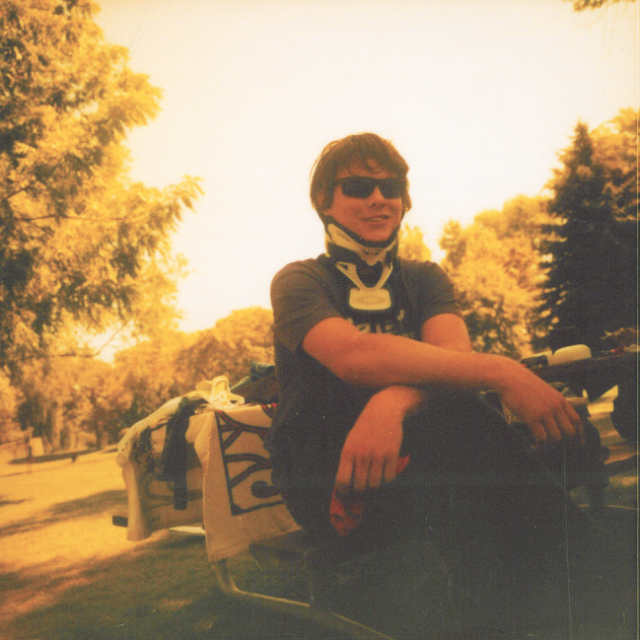
Survivor 2006. Photo: Letchworth
The party came to a screeching halt.
Danny would, of course, live and walk. But he still had to overcome significant damage to both his body and his psyche. The accident had left one of his arms virtually paralyzed from nerve damage, and the question of holding a handle again was initially not only physical, but philosophical. During the intensive rehabilitation, he had to reassess both his ability and desire to ride. And for a while, no one was quite sure what the answer was going to be.
I’ve seen a few scary things in my years in wake, and right up there at the top was a blustery day on a lake in Orlando about six months after his accident, after countless hours wondering is his neck would heal and if so how much it would heal, when Danny stood up in the boat and said, “I think I’m gonna’ ride today.” Honestly, none of us knew if we were about to witness something tragic. Obviously, the opposite came true.
Of course, it wasn’t exactly an express ride back to the top of the mountain. For a couple years, every time he started to gain some ground, new injuries would plague him: a broken ankle while filming for Oakley; a torn knee a few months after that return. Danny, in typical fashion, kept grinding. While filming for Push Process in South Africa Garrett Cortese spotted Danny sitting on the dock by himself crying. A lot had gone wrong up to that point, and he was struggling to understand if it would ever be right again. Later, when talking to Garrett about the time alone Danny just said, “That’s hunger.”
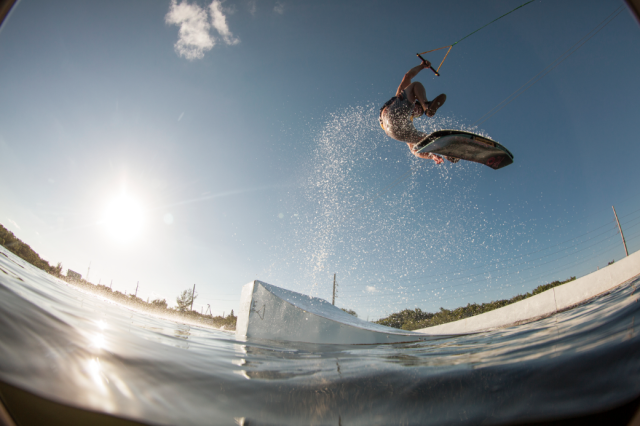
Present Day, Ever-present style. Keys Cable. Photo: Soderlind
Luckily, as with everything in his career up until that point, Danny got another chance. He and Aaron Reed teamed up with Liquid Force, already their wakeskate sponsor, to start Obscura Wakeskates, a company they still head up today. And in 2008, six years after coming onto the scene and changing the landscape of professional wakeskating, Alliance voted Danny Hampson its Rider of the Year. Why so long? I think it was because he made it look too easy. Nobody seemed to realize that he was actually putting in a lot of time and effort.
I left the wake world right around that time, and kind of lost track of Danny’s career. We remained close, talking every few months but never too much about wakeskating. I knew he was doing well, even winning a few contests here and there and always providing a spark to the new generation. In 2013, 11 years after Thomas had first started talking about “some kid he had watched ride in Miami”, I heard another rumor start to circulate. This time it came in a barrage of Facebook notifications – “Holy s**t! Watch Graceland with Danny Hampson.” I clicked on the link and as I settled in to the 8-minute clip I got the sense it was 2002 all over again – something and someone completely unique. This time it was peppered with years of knowing him and having shared countless good times and laughs. Of seeing him on the outer edge of sanity, and coming back from death’s doorstep. Of realizing that despite the early “Golden Child” tag and the mound of career highlights, that things haven’t always been smooth sailing for the Kid from the Keys. He just makes it look that way.
High tides and low.

Pure comfort. Photo: Soderlind
Words by Tony Smith
Airs: Saturday, August 15 at 2PM ET/12PM PT
Network: ABC – World of X Games
For more program info: xgames.espn.go.com

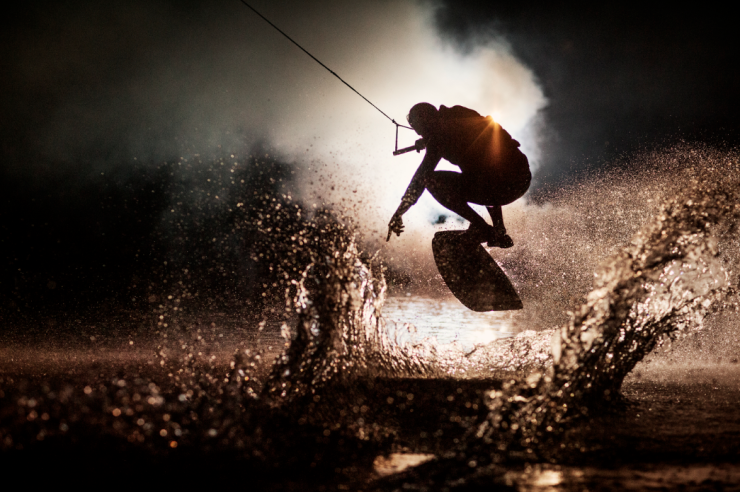






















November 25, 2015
1、 北斗系统是我国自主建设、独立运行的卫星导航系统,会上,具体方案还没最终定下来,之前的方案要求到2018年12月底,积极推进《食品安全法》和《农产品质量安全法》等法律法规修订;全面推进食品经营监管制度建设;稳妥推进食品经营许可制度改革,并研究制定了加强食用农产品入市后监管工作指导意见。有力推动了北斗产业化进程。请联系电话:。“这样村民早就散了,创新的痛点很可能就在手头每天的工作中。
January 23, 2016
I would like to use traction pads rather than using a wax. The reason for this was I wanted to be more focused on getting the basics down first. I didn't want to have to worry about waxing my board up each time I went out and hit the waves.To see more details here-Traction Pads
June 2, 2016
I always want to learn skating on tides but i have no sea by my place.I am currently working on Download latest movies blog related to films in Texas.
June 27, 2022
Miss Danny riding and writing for the magazine!
He was the best!!!